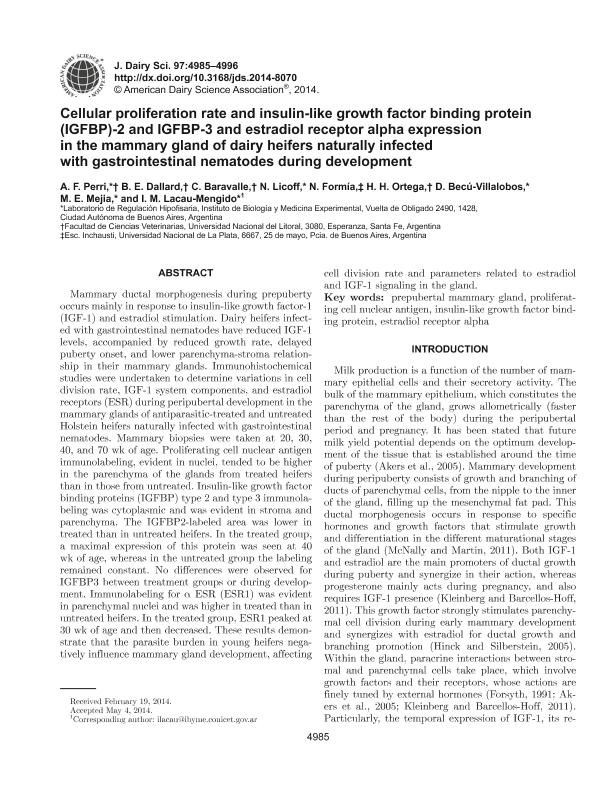Artículo
Cellular proliferation rate, and IGFBP-2 and -3 and estradiol receptor alpha expression in the mammary gland of dairy heifers naturally infected with gastrointestinal nematodes during development
Perri, Adrián Francisco ; Dallard, Bibiana Elisabet
; Dallard, Bibiana Elisabet ; Baravalle, Celina
; Baravalle, Celina ; Licoff, N.; Formia, N.; Ortega, Hugo Hector
; Licoff, N.; Formia, N.; Ortega, Hugo Hector ; Becu, Damasia
; Becu, Damasia ; Mejia, M. E.; Lacau, Isabel Maria
; Mejia, M. E.; Lacau, Isabel Maria
 ; Dallard, Bibiana Elisabet
; Dallard, Bibiana Elisabet ; Baravalle, Celina
; Baravalle, Celina ; Licoff, N.; Formia, N.; Ortega, Hugo Hector
; Licoff, N.; Formia, N.; Ortega, Hugo Hector ; Becu, Damasia
; Becu, Damasia ; Mejia, M. E.; Lacau, Isabel Maria
; Mejia, M. E.; Lacau, Isabel Maria
Fecha de publicación:
08/2014
Editorial:
Elsevier
Revista:
Journal of Dairy Science
ISSN:
0022-0302
Idioma:
Inglés
Tipo de recurso:
Artículo publicado
Clasificación temática:
Resumen
Mammary ductal morphogenesis during prepuberty occurs mainly in response to insulin-like growth factor-1 (IGF-1) and estradiol stimulation. Dairy heifers infected with gastrointestinal nematodes have reduced IGF-1 levels, accompanied by reduced growth rate,delayed puberty onset, and lower parenchyma-stroma relationship in their mammary glands. Immunohistochemical studies were undertaken to determine variations in cell division rate, IGF-1 system components, and estradiol receptors (ESR) during peripubertal development in the mammary glands of antiparasitictreated and untreated Holstein heifers naturally infected with gastrointestinal nematodes. Mammary biopsies were taken at 20, 30, 40, and 70 wk of age. Proliferating cell nuclear antigen immunolabeling, evident in nuclei, tended to be higher in the parenchyma of the glands from treated heifers than in those from untreated. IGF binding proteins (IGFBP) type 2 and type 3 immunolabeling was cytoplasmic and was evident in stroma and parenchyma. The IGFBP2-labeled area was lower in treated than in untreated heifers. In the treated group, a maximal expression of this protein was seen at 40 wk of age, whereas in the untreated group the labeling remained constant. No differences were observed for IGFBP3 between treatment groups or during development. Immunolabeling for α ESR (ESR1) was evident in parenchymal nuclei and was higher in treated than in untreated heifers. In the treated group, ESR1 peaked at 30 wk of age and then decreased. These results demonstrate that the parasite burden in young heifers negatively influence mammary gland development, affecting cell division rate and parameters related to estradiol and IGF-1 signaling in the gland.
Palabras clave:
Parasite
,
Milk
,
Mammary Gland
,
Heifer
Archivos asociados
Licencia
Identificadores
Colecciones
Articulos(IBYME)
Articulos de INST.DE BIOLOGIA Y MEDICINA EXPERIMENTAL (I)
Articulos de INST.DE BIOLOGIA Y MEDICINA EXPERIMENTAL (I)
Articulos(ICIVET-LITORAL)
Articulos de INST. DE CIENCIAS VETERINARIAS DEL LITORAL
Articulos de INST. DE CIENCIAS VETERINARIAS DEL LITORAL
Citación
Perri, Adrián Francisco; Dallard, Bibiana Elisabet; Baravalle, Celina; Licoff, N.; Formia, N.; et al.; Cellular proliferation rate, and IGFBP-2 and -3 and estradiol receptor alpha expression in the mammary gland of dairy heifers naturally infected with gastrointestinal nematodes during development; Elsevier; Journal of Dairy Science; 97; 8; 8-2014; 4985-4996
Compartir
Altmétricas



